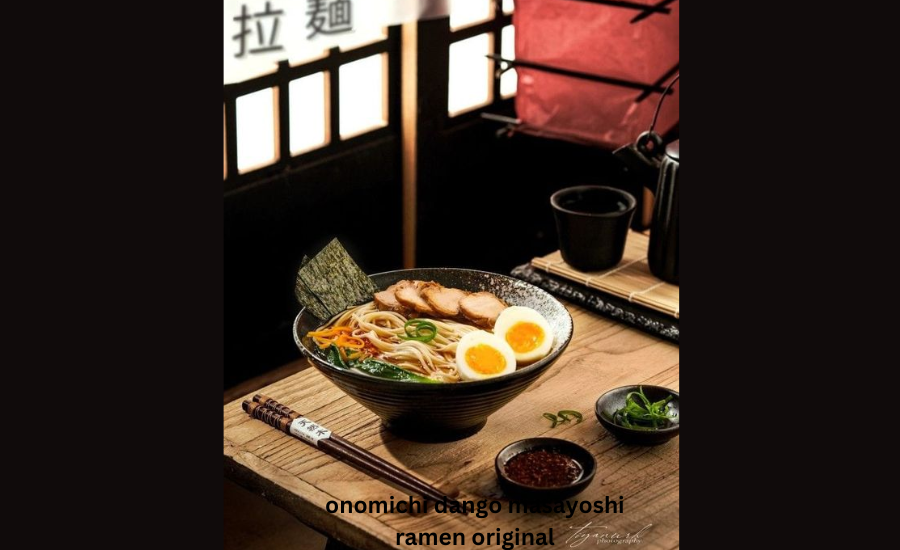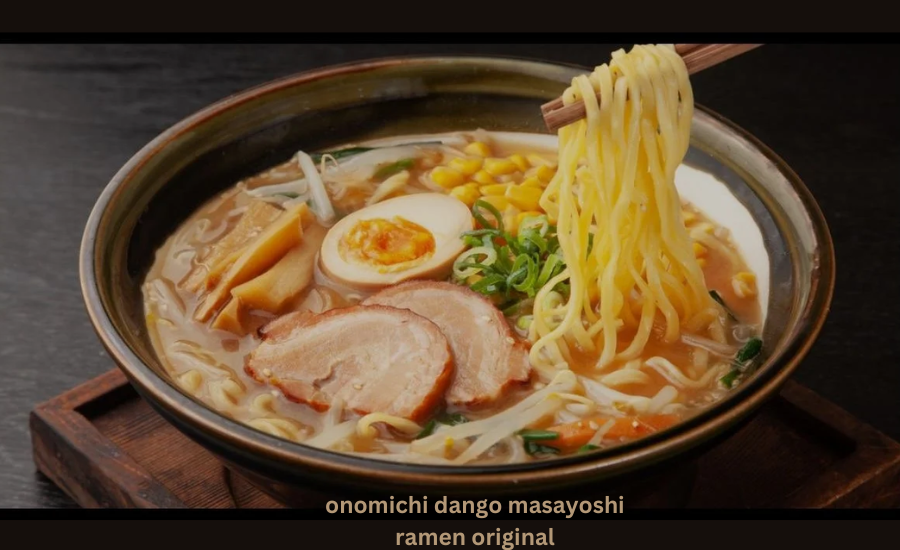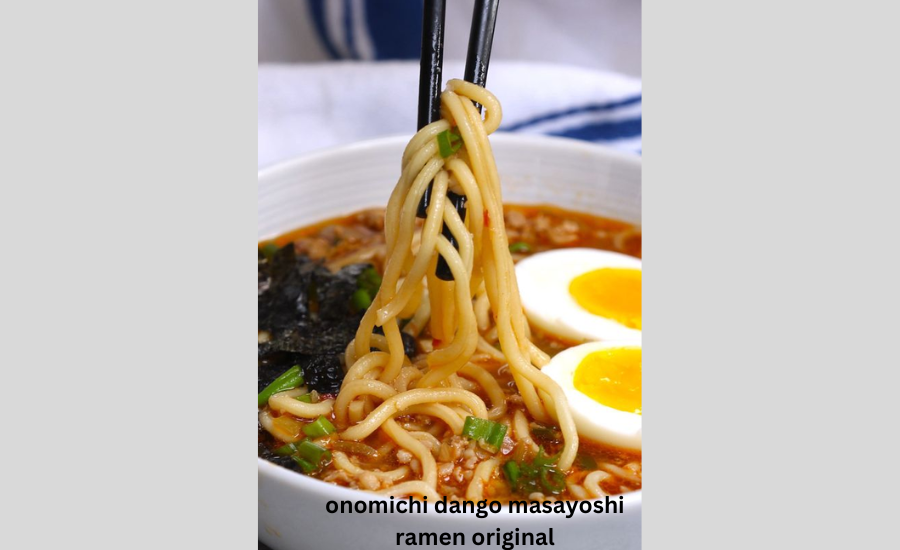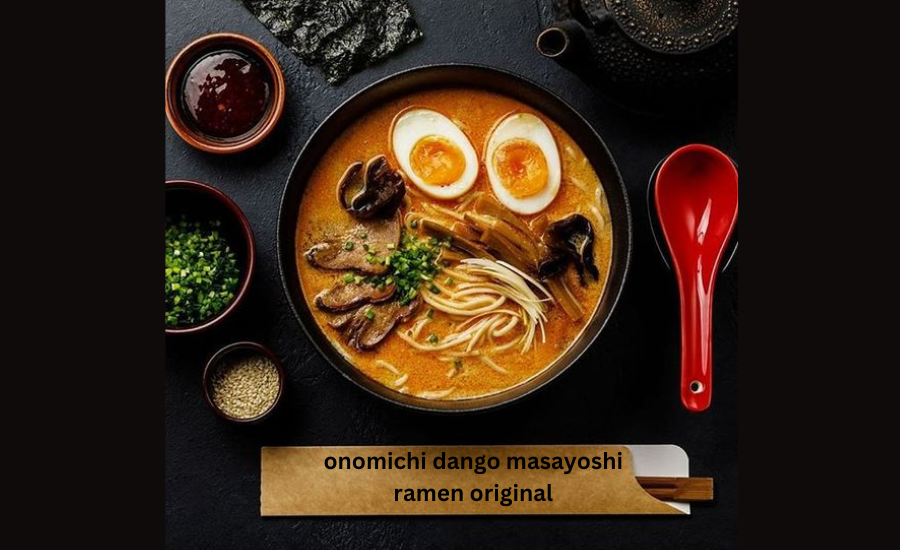Japanese cuisine is globally celebrated for its rich traditions, distinctive flavors, and historical depth. One exceptional dish that exemplifies this heritage is Onomichi Dango Masayoshi Original Ramen. This isn’t just a typical ramen; it’s a culinary journey that takes you to the charming coastal town of Onomichi in Hiroshima Prefecture. What sets this dish apart is its fusion of handmade dango, authentic ramen noodles, and the iconic Masayoshi broth, creating an unforgettable experience that has earned its place as a highlight of Japanese gastronomy.
In this detailed exploration, we will dive into the history of Onomichi Dango Masayoshi Ramen Original, uncovering its roots and cultural significance. You’ll learn about the traditional ingredients that make this dish unique and discover the artistry behind its preparation. Additionally, we’ll share a step-by-step guide on how to recreate this authentic ramen at home, along with answering frequently asked questions about this iconic Japanese dish, offering insights into its legacy and continued relevance today.
The History Behind Onomichi Dango Masayoshi Ramen Original
The story of Onomichi Dango Masayoshi Ramen Original traces its roots back to Japan’s post-war period, a time when culinary traditions were evolving rapidly. Nestled in the picturesque coastal town of Onomichi, famous for its bustling port and stunning landscapes, this dish began to take shape as a local favorite. The area’s rich culinary traditions, which centered around fresh seafood and noodles, laid the groundwork for the development of this distinct ramen style.
Masayoshi, a revered local chef, took the traditional ramen recipe a step further by introducing dango—soft, chewy Japanese dumplings—into the dish. His innovation created a delightful fusion of flavors and textures that set the ramen apart from others. This unique combination quickly gained popularity, with locals and visitors alike flocking to taste the perfect marriage of handmade noodles, savory broth, and the unexpected yet satisfying addition of dango.
Today, Onomichi Dango Masayoshi Ramen Original stands as a beloved symbol of culinary craftsmanship and creativity, representing the blend of traditional Japanese flavors with inventive twists that continue to captivate ramen enthusiasts worldwide.

Distinctive Ingredients of Onomichi Dango Masayoshi Ramen Original
The signature Onomichi Dango Masayoshi Ramen Original is crafted using a selection of premium ingredients, each playing a crucial role in delivering its unique and memorable taste:
Savory Handmade Dango
Unlike the sweet dango often found in Japanese desserts, the dango in this ramen is savory and made from a mixture of ground meat and flour. These dumplings have a soft, tender texture that pairs perfectly with the noodles, adding depth and heartiness to the dish.
Firm Ramen Noodles
Onomichi ramen stands out for its straight, firm noodles, which provide a satisfying bite. The firm texture holds up well in the rich broth, offering a more substantial feel compared to other ramen varieties with softer, curly noodles.
Rich Masayoshi Broth
The hallmark of this dish is its luxurious broth, which is simmered slowly to extract intense flavors. Made from a combination of pork bones, dried sardines, and soy sauce, the broth strikes the perfect balance between umami, saltiness, and the essence of the sea. Its thick, rich consistency coats the noodles and dango, ensuring every bite is packed with flavor.
Fresh Seafood Garnish
Owing to Onomichi’s coastal location, fresh local seafood often accompanies the dish. Ingredients like squid or shrimp add a layer of complexity and a fresh, briny taste that enhances the ramen’s overall profile, offering a delightful contrast to the savory broth and dumplings.
Each of these ingredients contributes to the distinctive nature of Onomichi Dango Masayoshi Ramen Original, making it a standout among Japan’s many beloved ramen styles.
The Cultural Importance of Onomichi Ramen
Onomichi Ramen is not merely a dish; it embodies the rich history, traditions, and lifestyle of the coastal town of Onomichi. As a port city, Onomichi has long been tied to the sea, and its ramen reflects this deep connection. The use of fresh, locally sourced ingredients like seafood highlights the town’s maritime heritage, while the dish itself has become a symbol of the region’s unique culinary identity. Travelers from around the world visit Onomichi not only for its picturesque scenery but also to experience the authentic flavors of this renowned ramen, often enjoyed at small, family-owned ramen shops that have been part of the town for generations.
The Masayoshi variation of Onomichi Ramen Original adds another layer of cultural significance by blending tradition with innovation. By incorporating savory dango into the ramen, Masayoshi not only honored classic Japanese cuisine but also pushed its boundaries, merging two iconic dishes into one. This creative twist on tradition has earned widespread acclaim, with the dish gaining popularity both within Japan and internationally. Onomichi Ramen, particularly the Masayoshi version, stands as a testament to the town’s culinary creativity and its ability to preserve authenticity while embracing modern influences. It serves as a lasting symbol of Onomichi’s proud gastronomic culture.
How to Make Onomichi Dango Masayoshi Ramen Original at Home

If you’re unable to visit Onomichi but still want to enjoy the distinct flavors of Onomichi Dango Masayoshi Ramen, you can recreate it at home with this easy-to-follow recipe. Achieving the authentic taste lies in carefully selecting high-quality ingredients and taking your time with the broth preparation.
Ingredients:
- 200g firm, straight ramen noodles
- 250g pork bones
- 100g dried sardines
- 4 tbsp soy sauce
- 2 cloves garlic, minced
- 200g ground pork (for the dango dumplings)
- 1 egg
- 50g flour
- Optional: Fresh seafood (shrimp, squid)
- Spring onions for garnish
Instructions:
- Prepare the broth: In a large pot, combine pork bones and dried sardines with enough water to cover them. Bring to a boil, then lower the heat and maintain a gentle simmer. Allow the broth to cook for at least 4 hours, skimming off impurities occasionally. Add soy sauce and minced garlic, and let it simmer for an additional hour to deepen the flavors.
- Make the dango: In a bowl, mix ground pork, egg, and flour until well combined. Form small dumplings (dango) from the mixture, and set aside.
- Cook the noodles: Boil the ramen noodles according to the package instructions until firm. Drain and set aside.
- Brown the dango: In a separate pan, cook the dango dumplings until they are browned on all sides. Transfer the dango to the broth and let them simmer for 10 minutes, allowing them to absorb the rich flavors of the broth.
- Assemble the dish: Place the cooked ramen noodles into bowls. Pour the hot broth over the noodles, ensuring the dango are included. If you are using fresh seafood like shrimp or squid, you can add them at this point. Garnish the dish with chopped spring onions for a burst of freshness.
Optional: For an extra touch of authenticity, serve the ramen with a side of pickled vegetables or seaweed to enhance the overall experience.
Top Spots to Enjoy Onomichi Dango Masayoshi Ramen in Japan
For those lucky enough to visit Japan, there’s no better way to appreciate the full flavor of Onomichi Dango Masayoshi Ramen than by enjoying it in its hometown. Here are some of the best places to experience this dish firsthand:
Masayoshi Ramen Shop
As the birthplace of Onomichi Dango Masayoshi Ramen, this iconic ramen shop is a must-visit for anyone eager to taste the original recipe. Known for its authentic preparation, it offers an unforgettable dining experience.
Shukaen
One of Onomichi’s oldest ramen establishments, Shukaen is known for blending tradition with modern culinary twists. Their take on Onomichi ramen is slightly updated but remains deeply rooted in the town’s ramen-making heritage.
Ramen Ichiban
Located near the bustling Onomichi Port, Ramen Ichiban provides both a delicious bowl of Onomichi Dango Masayoshi Ramen and stunning views of the sea. The combination of flavorful ramen and scenic surroundings makes this spot a local favorite.
Each of these ramen shops offers a unique take on the classic dish, making them well worth the visit for any ramen lover exploring Onomichi.
Nutritional Benefits of Onomichi Dango Masayoshi Ramen
While often regarded as a comfort food, Onomichi Dango Masayoshi Ramen provides several health benefits, particularly when made with fresh, high-quality ingredients. The seafood commonly used in this dish, such as squid or shrimp, is an excellent source of omega-3 fatty acids, which are known to promote heart health and reduce inflammation. These essential fatty acids also support brain function and improve overall cardiovascular health.
The broth, simmered from pork bones, is another nutritional highlight. It is rich in collagen, a protein that plays a key role in maintaining healthy skin, joints, and connective tissues. Collagen helps to keep the skin firm and elastic while also supporting joint flexibility, making the broth a valuable addition to your diet.
Dango, the savory dumplings made from lean ground pork, provide a high protein content, which is essential for muscle repair, growth, and overall bodily function. This makes Onomichi Dango Masayoshi Ramen a well-rounded meal in terms of its protein contribution.
Although ramen is known for its relatively high sodium levels, which should be consumed in moderation, the dish can be part of a healthy, balanced diet when paired with nutrient-dense ingredients like vegetables and seafood. Adding leafy greens, spring onions, and fresh herbs can increase the dish’s vitamin and mineral content, making it both nutritious and delicious.
The Worldwide Appeal of Onomichi Dango Masayoshi Ramen
Ramen’s rise to global fame has led to a surge in demand for regional variations, and Onomichi Dango Masayoshi Ramen is no exception. This distinctive ramen, with its innovative inclusion of savory dango, has captured the attention of food lovers and culinary experts worldwide. The fusion of traditional ramen elements with Masayoshi’s creative twist has inspired chefs across the globe to experiment with their own versions of the dish.
Many ramen shops outside Japan have started incorporating dango into their ramen, paying tribute to Onomichi’s culinary heritage while appealing to the growing interest in Japanese cuisine. As Onomichi Dango Masayoshi Ramen continues to spread internationally, it showcases not only the versatility of ramen but also the creativity and depth of Japanese cooking traditions, making it a sought-after dish for adventurous foodies everywhere.

Frequently Asked Questions (FAQs)
Q: What is Onomichi Dango Masayoshi Ramen Original?
A: Onomichi Dango Masayoshi Ramen is a unique variation of ramen originating from the coastal town of Onomichi in Hiroshima Prefecture. What sets it apart is the inclusion of savory dango (Japanese dumplings) made from ground pork, combined with firm ramen noodles and a rich broth made from pork bones, dried sardines, and soy sauce. The dish reflects the region’s maritime culture and culinary traditions.
Q: What makes the broth in Onomichi Dango Masayoshi Ramen special?
A: The broth is one of the key features of this ramen. It is slowly simmered using pork bones and dried sardines, which give it a deep, umami-rich flavor. Soy sauce and garlic add further layers of complexity, resulting in a thick, savory broth that perfectly complements the dango and ramen noodles.
Q: How is the dango in this ramen different from traditional dango?
A: While traditional dango is often a sweet rice cake enjoyed as a dessert, the dango in Onomichi Dango Masayoshi Ramen is savory. Made from ground pork and flour, these dumplings have a tender texture and a rich, meaty flavor, offering a hearty addition to the dish.
Q: Can I make Onomichi Dango Masayoshi Ramen Original at home?
A: Yes, you can recreate this dish at home by following a recipe that carefully guides you through making the broth, ramen noodles, and dango dumplings. High-quality ingredients, particularly fresh seafood and slow-simmered broth, are key to achieving an authentic flavor.
Q: Is Onomichi Dango Masayoshi Ramen healthy?
A: While ramen is often seen as comfort food, this variation offers several health benefits, particularly due to its use of fresh seafood and nutrient-rich broth. The seafood provides omega-3 fatty acids for heart health, while the broth’s collagen supports skin and joint health. However, like most ramen, it should be enjoyed in moderation due to its sodium content.
Q: Where can I try the authentic version of Onomichi Dango Masayoshi Ramen Original?
A: To experience the authentic version, visiting Onomichi is recommended. Iconic ramen shops such as Masayoshi Ramen Shop, Shukaen, and Ramen Ichiban offer different takes on the dish, each providing a unique and authentic dining experience.
Q: How has Onomichi Dango Masayoshi Ramen gained global popularity?
A: With ramen’s rise in global popularity, many chefs around the world have begun experimenting with regional variations, including Onomichi Dango Masayoshi Ramen. Its unique combination of savory dango and rich broth has made it a favorite among food enthusiasts internationally, leading to creative adaptations in ramen shops outside of Japan.
Conclusion
Onomichi Dango Masayoshi Ramen Original, hailing from Onomichi in Hiroshima Prefecture, embodies a unique fusion of tradition and innovation in Japanese cuisine. Combining savory dango, firm ramen noodles, and a rich, umami-packed broth, this ramen stands out with its distinctive flavor profile. The addition of fresh seafood underscores its ties to Onomichi’s maritime heritage. Originally crafted by Chef Masayoshi, this ramen has gained acclaim both in Japan and internationally, attracting food enthusiasts with its creative twist on classic ingredients. Its nutritional benefits, including omega-3 fatty acids from seafood and collagen from the broth, enhance its appeal. Whether enjoyed at an authentic ramen shop or made at home, Onomichi Dango Masayoshi Ramen highlights the rich cultural and culinary depth of Japanese cuisine.
Read Next: Snapilogue
